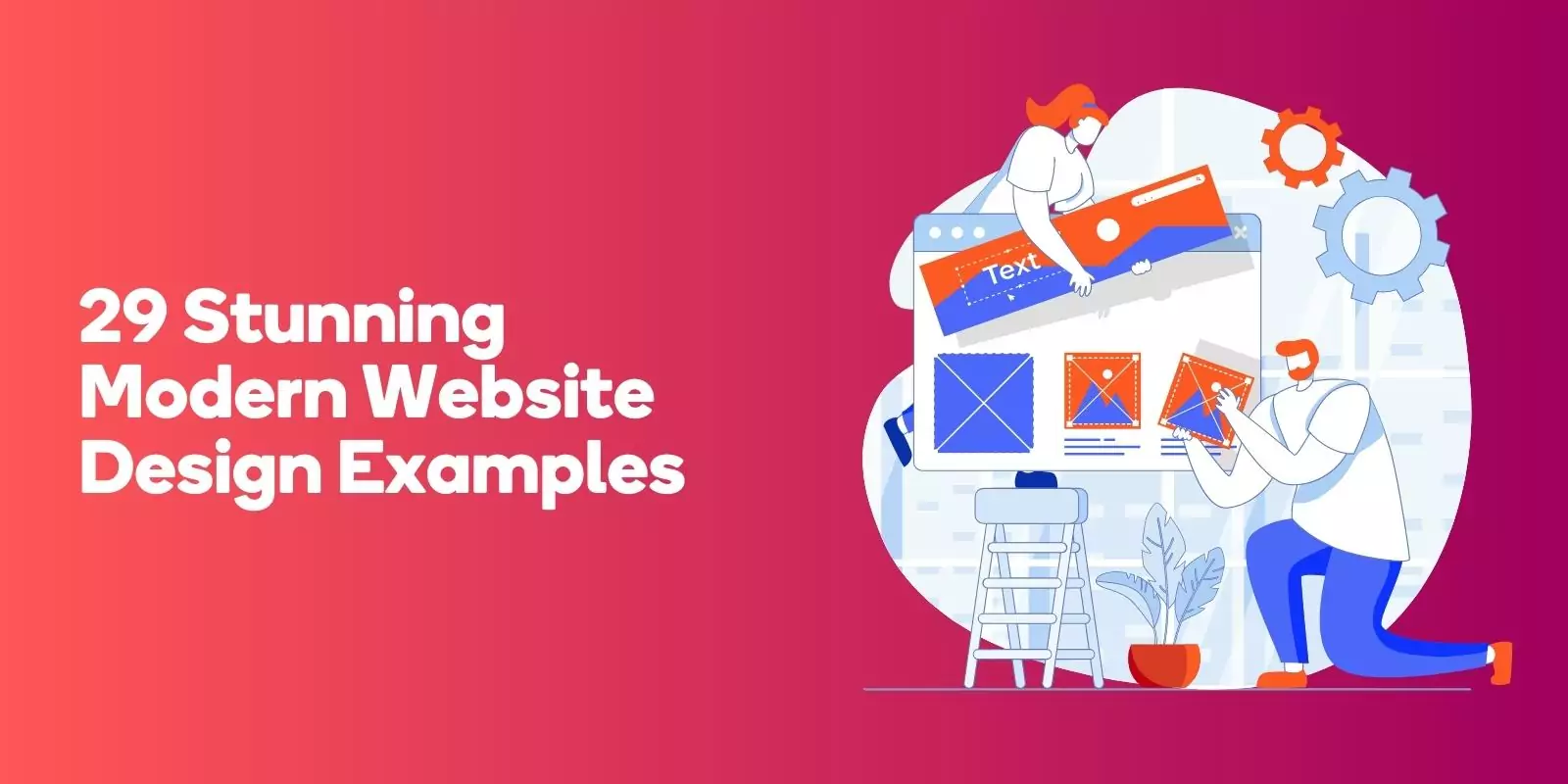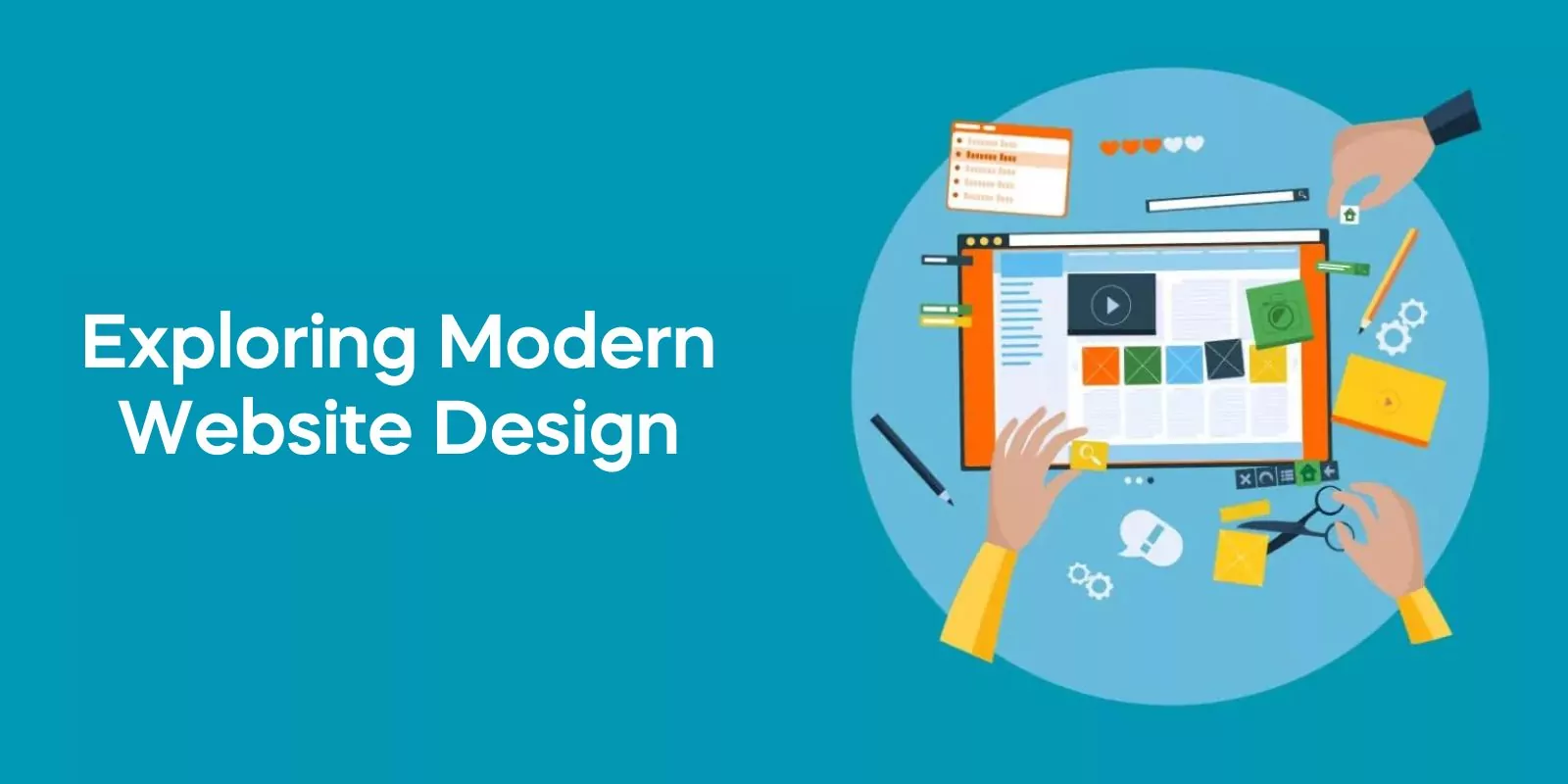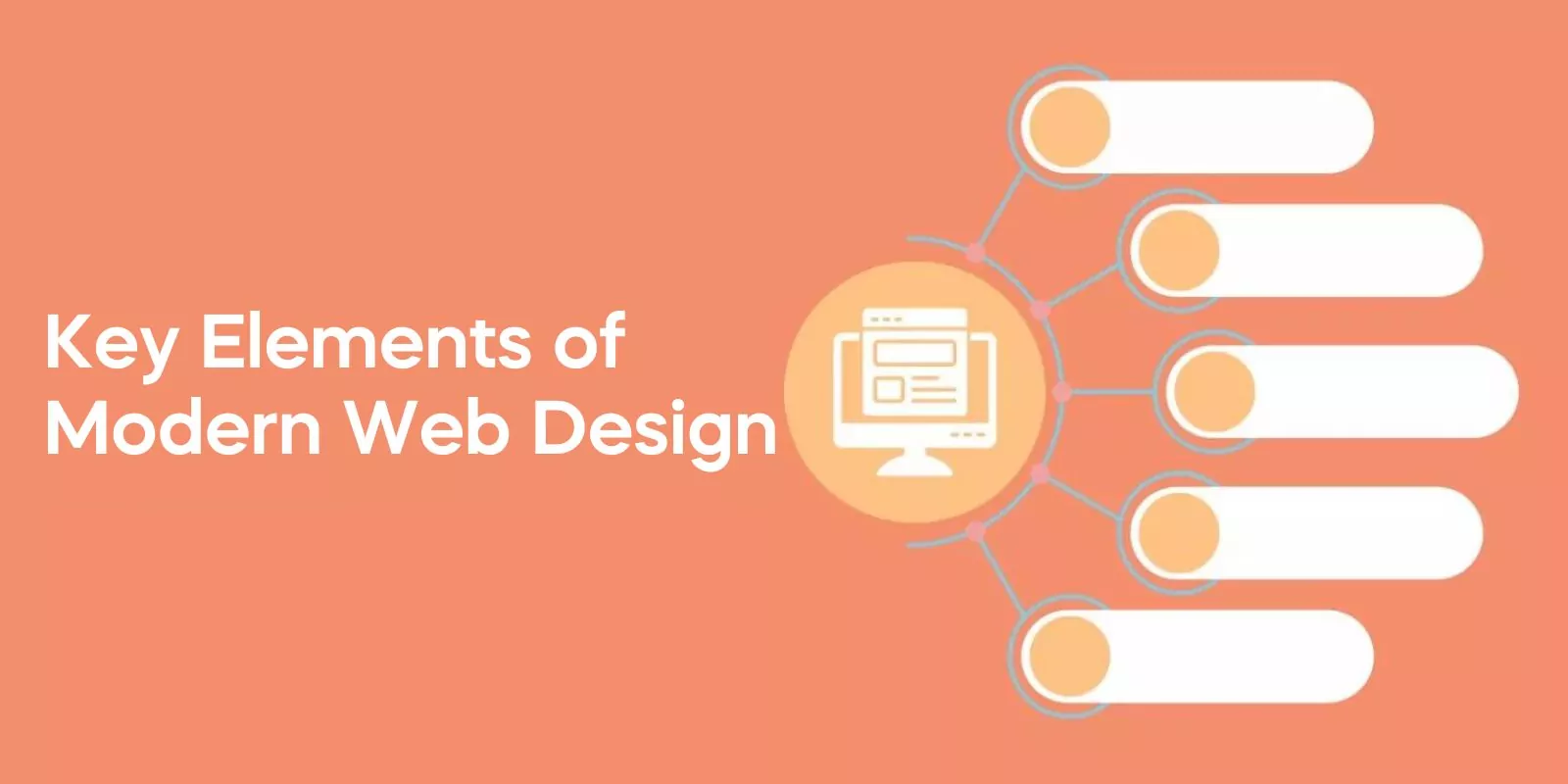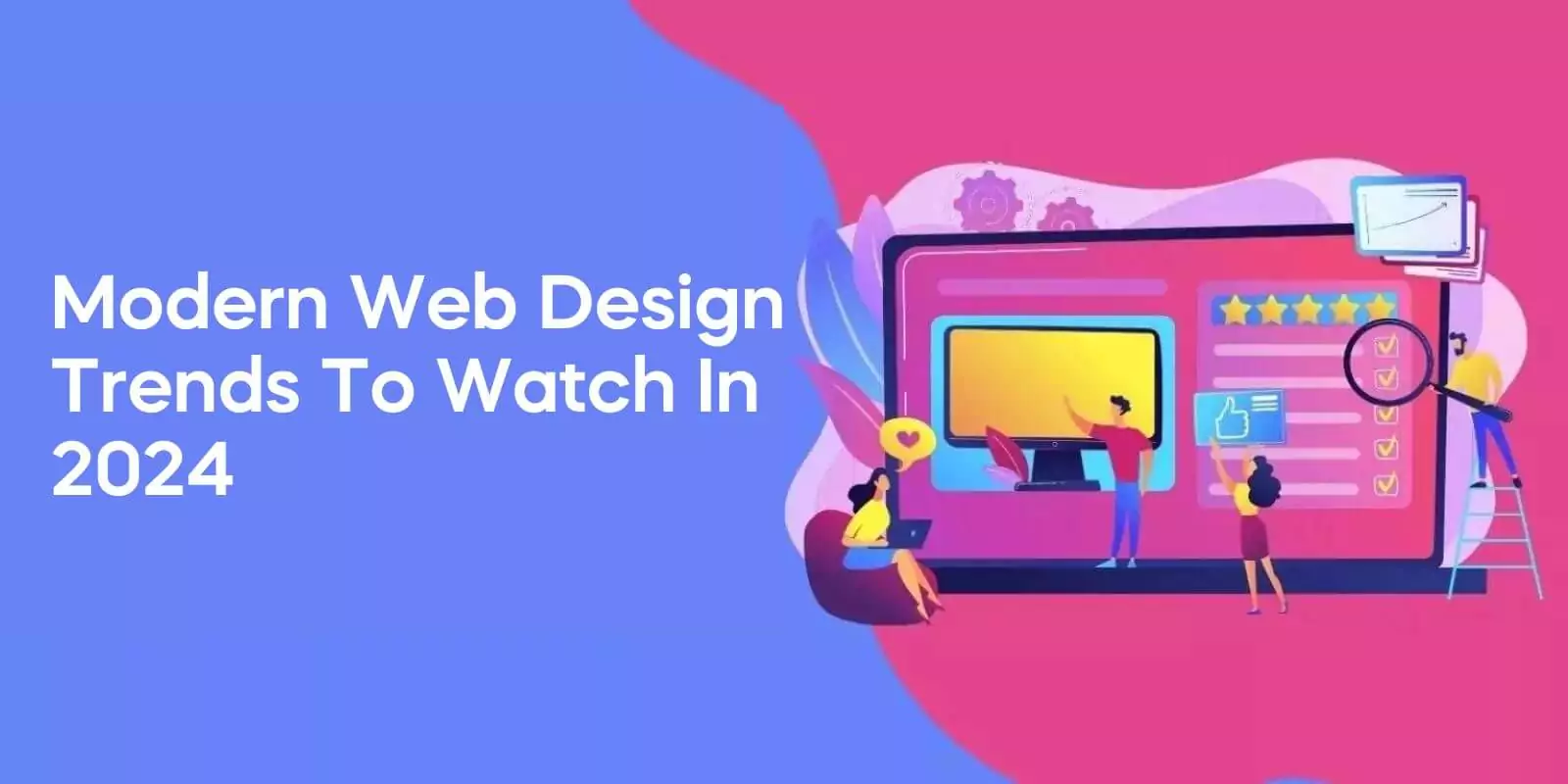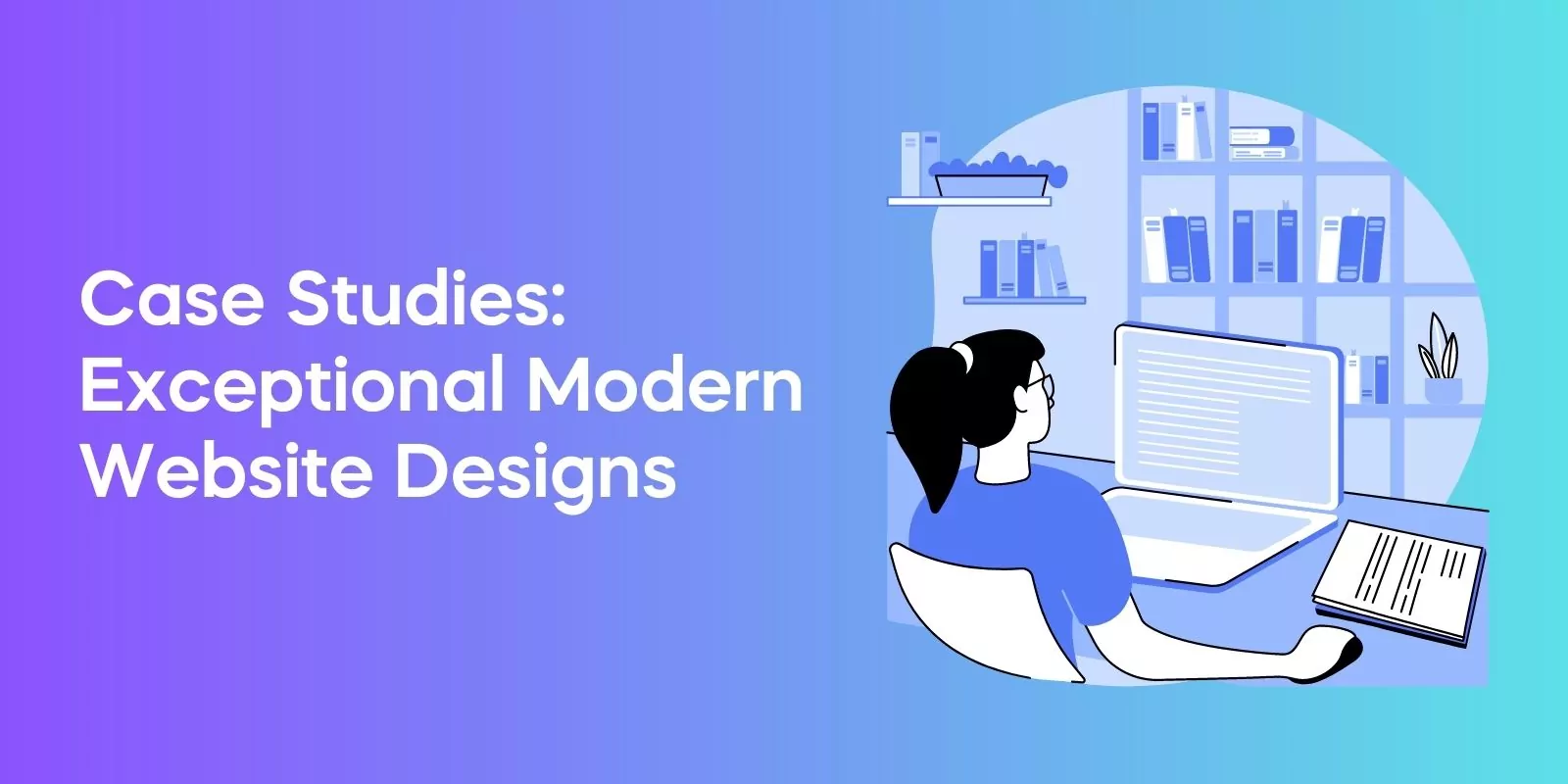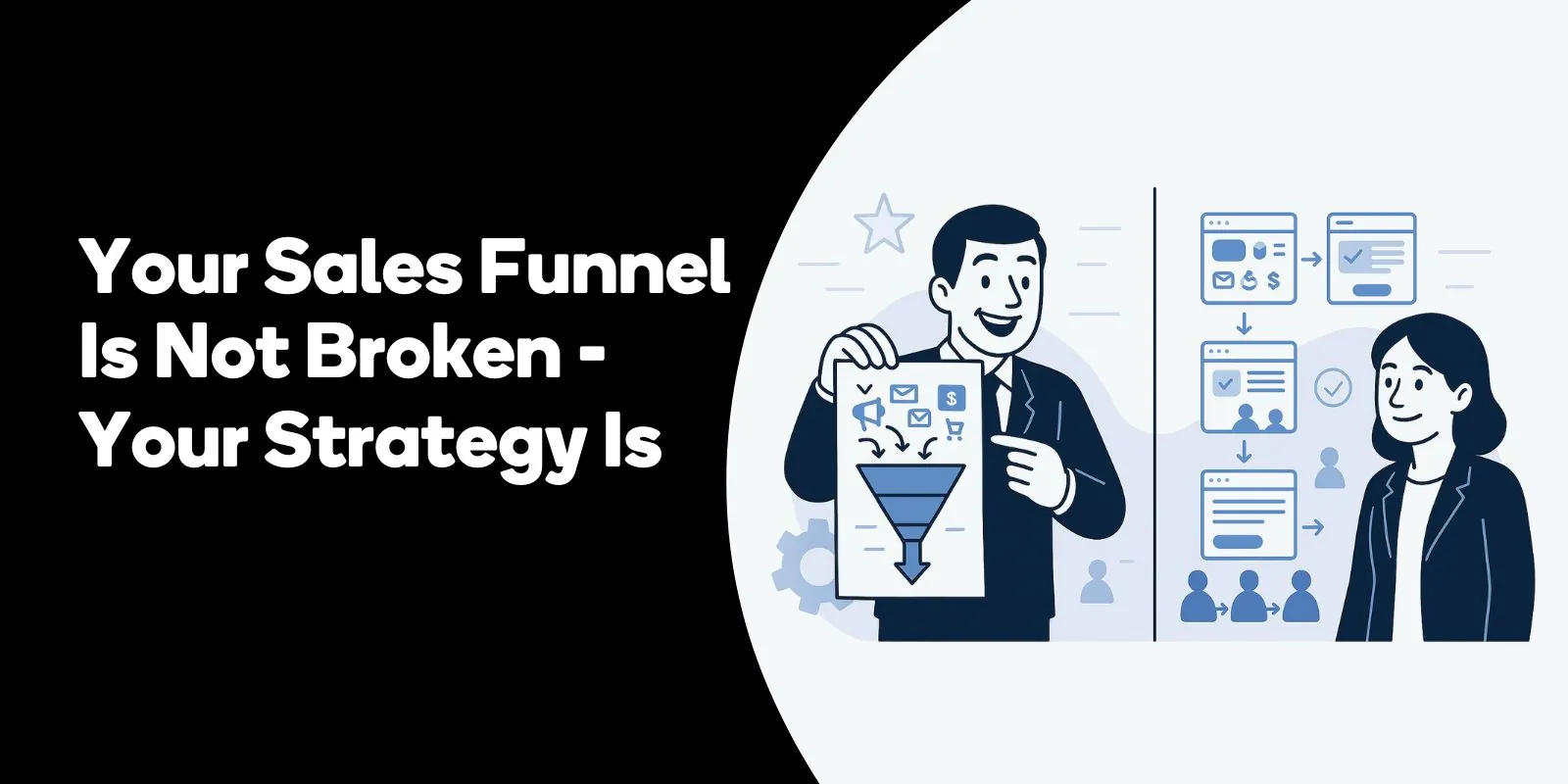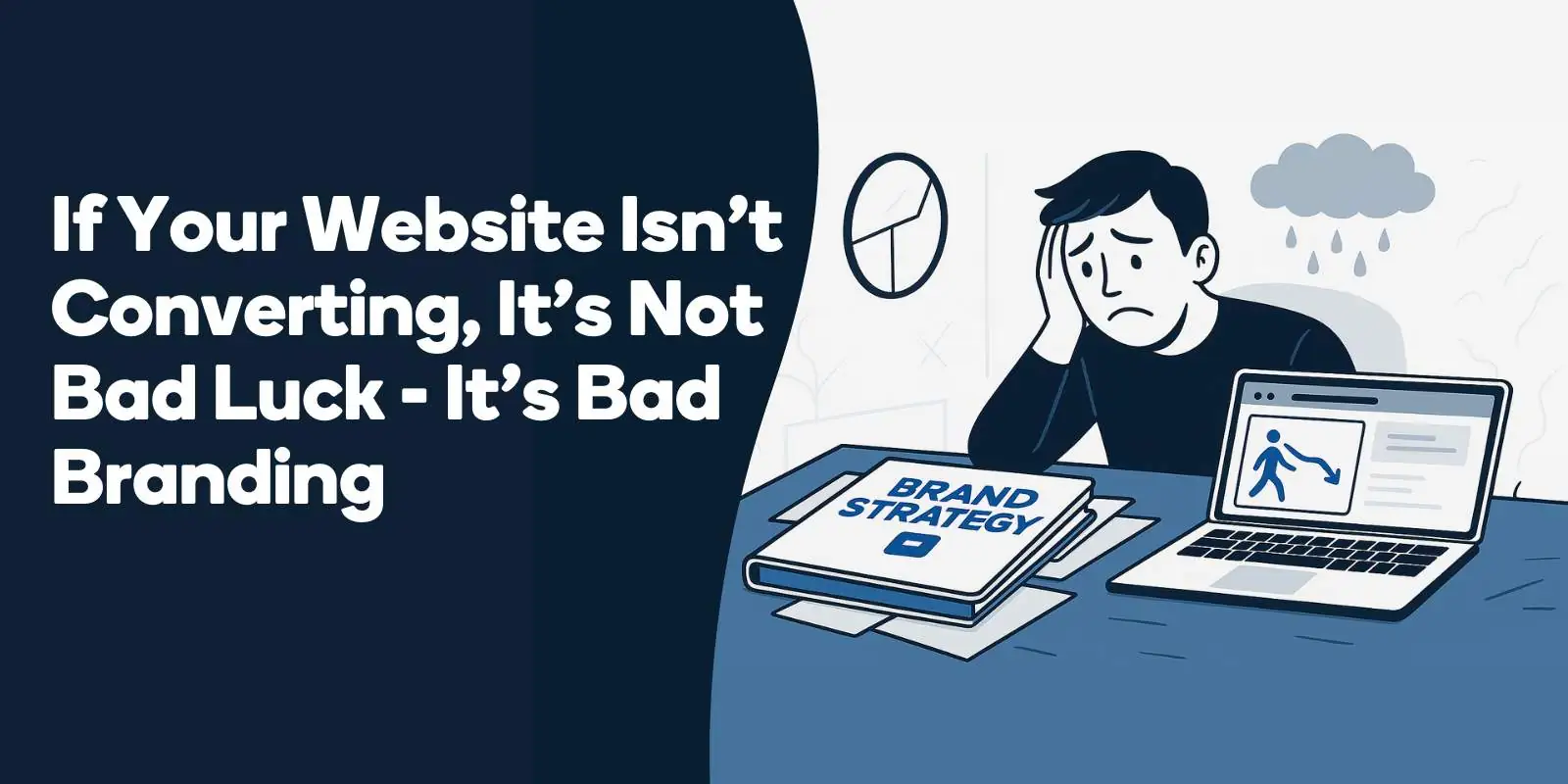In this blog post, we’ll explore the key elements and most anticipated trends in modern web design, providing you with invaluable insights and inspiration to create visually stunning and highly engaging websites.
Exploring Modern Website Design
The world of modern website design is ever-changing, and staying ahead of the curve is vital for businesses and web designers alike.
A well-designed website can captivate your audience, maintain their engagement, and ultimately drive sales and conversions.
Research has revealed that a whopping 75% of users form an opinion about the credibility of a website and business just based on its design.
This goes to show how important it is to have a well-designed website. In this fast-paced digital era, first impressions matter, and having an eye-catching and engaging website is paramount for success.
Modern web design is characterized by modern website design trends such as minimalism and simplicity, bold typography and color schemes, responsiveness and mobile-first design, dynamic scrolling and interactivity, and custom illustrations and imagery.
These design elements not only provide a visually appealing experience, but also ensure that your web page is user-friendly and accessible to a wide range of audiences. For those seeking modern web design inspiration, incorporating web development practices alongside these elements is essential to consider.
Let’s delve deeper into these key features, which serve as the foundation for creating exceptional modern websites.
Minimalism and Simplicity
Minimalism and simplicity have become a popular trend in modern website design, emphasizing the importance of having fewer elements in a design for improved aesthetics.
The philosophy behind minimalistic web design is “less is more”, and its prevalence in modern design provides users with a convenient, contemporary, and attractive aesthetic. By incorporating ample white space, clean layouts, and easy navigation, minimalistic design can create an engaging user experience while reducing clutter and distractions.
The use of white space, or negative space, is particularly significant in establishing relationships between page elements. It plays an important role in helping visitors identify a site’s hierarchy and assists in guiding them through the site pages, much like natural currents transitioning from one element to the next.
By adopting a minimalistic design approach, businesses can create websites that perfectly fit the needs of their target audience while ensuring an aesthetically pleasing and easily navigable user experience.
Bold Typography and Color Schemes
Typography and color psychology play a crucial role in modern web design, as they directly influence the readability and overall look of a website.
Bold typography and striking color schemes can make a powerful statement, capturing the audience’s attention and reinforcing brand identity. In today’s digital landscape, businesses must stand out to be successful, and employing visually appealing typography and color schemes can be a significant differentiation.
Online color palettes in 2024 are anticipated to become more muted, with A.I. Aqua being identified as the color of the year.
Dark mode, a display setting that utilizes a dark background with light text, has also gained popularity in modern web design due to its ability to reduce eye strain, lessen glare, and potentially contribute to better sleep.
By experimenting with color trends and bold typography, businesses can create an engaging and visually appealing website that effectively communicates their brand message and captures the attention of their target audience.
Responsive and Mobile-First Design
As more and more users access websites through mobile devices, responsive and mobile-first design has become an essential component of modern web design.
A responsive website ensures optimal performance across various devices and screen sizes, making it easy for users to navigate and interact with the site regardless of the device they are using.
Mobile-first design involves creating a website with mobile devices as the primary focus, then scaling up for larger screens.
The significance of mobile responsiveness in contemporary web design cannot be overstated. To ensure a successful contemporary web design in 2024, all of its components must be able to transition seamlessly to both desktop and mobile.
Mobile responsive animations and videography will become increasingly necessary for web design, catering to the growing number of users who access websites through their smartphones and tablets.
By prioritizing responsive and mobile-first design, businesses can create websites that cater to a vast audience, ensuring a seamless and enjoyable user experience across all devices.
Dynamic Scrolling and Interactivity
Dynamic scrolling and interactivity have become prominent features in modern web design, offering immersive experiences through parallax effects, animations, and other interactive elements.
Dynamic scrolling involves the use of varying scroll speeds for the website’s foreground and background to create a 3D visual effect.
This technique can add depth and realism to a website, providing a more engaging and interactive experience for users.
In addition to dynamic scrolling, modern web design also incorporates various interactive elements such as playful cursors, which involve creating dynamic experiences through visually engaging effects and animation.
By incorporating these elements into their designs, businesses can create captivating websites that not only look visually appealing but also provide an engaging and memorable user experience.
This combination of dynamic scrolling and interactivity can significantly enhance the overall quality of a website, making it stand out in the competitive digital landscape.
Custom Illustrations and Imagery
Custom illustrations and imagery have become a popular trend in modern web design, providing unique visuals that enhance brand identity and user engagement.
By incorporating custom illustrations and imagery in their designs, businesses can create a distinct visual identity that effectively communicates their brand message and fosters a personal connection between the brand and its web visitors.
Digital designs are increasingly incorporating 3D illusions that provide an extra level of depth to the web, further enhancing the visual appeal of modern websites.
The use of custom illustrations and imagery not only differentiates a website from its competitors, but also adds a touch of creativity and authenticity to the overall design.

Award-Winning
Sales Funnel & Website Expert
Discover How My Agency Can Grow Your Business
- Website: Our websites are the perfect blend of form and function.
- Sales Funnel: We build sales funnels that turn leads into customers.
- SEO: Get found online with our expert SEO services.
By embracing this trend, businesses can create visually stunning websites that effectively showcase their unique brand identity and captivate their target audience.
Key Elements of Modern Web Design
The essential components of modern web design consist of minimalism, responsive design, white space, typography, and imagery.
These key elements play a vital role in creating a successful and visually appealing website, ensuring that it caters to the needs of its target audience while staying true to the brand’s identity.
By understanding and incorporating these essential elements, businesses can create websites that not only look stunning but also provide an engaging and enjoyable user experience.
User experience (UX) is a critical aspect of modern web design, as it impacts everything from usability and accessibility to navigation and content strategy.
A well-designed website should prioritize UX, ensuring that it is user-friendly, easy to navigate, and accessible across various devices and platforms.
By focusing on these key elements, businesses can create websites that effectively communicate their brand message, captivate their audience, and drive conversions and sales.
User Experience (UX)
User experience (UX) is a crucial component of modern web design, as it directly influences how users interact with a website and the overall impression they form of the brand.
Prioritizing UX in web design ensures that the website is visually appealing and user-friendly, catering to the needs of its target audience and providing an enjoyable online experience.
To create a positive user experience, businesses should focus on factors such as usability, accessibility, and intuitive navigation.
This includes designing websites that are easy to navigate, with clear and concise content that is easy to read and understand.
Additionally, modern websites should be accessible across various devices and platforms, ensuring that users can interact with the site regardless of the device they are using.
By prioritizing UX in web design, businesses can create websites that effectively engage their audience and foster loyalty.
Visual Hierarchy
Visual hierarchy is a critical aspect of web design, as it helps guide users’ attention to the most essential information first.
By arranging design elements in a way that directs the viewer’s attention to the most pertinent information, users can quickly and effectively locate the desired information, enhancing their overall experience with the website.
Proper organization and arrangement of elements is essential for creating a positive user experience. White space plays an important role in helping visitors identify a site’s hierarchy and assists in guiding them through the site pages, much like natural currents transitioning from one element to the next.
By focusing on visual hierarchy in web design, businesses can ensure that their website effectively communicates their brand message and provides users with a seamless and enjoyable browsing experience.
Content Strategy
A well-planned content strategy is essential for modern web design, ensuring that relevant and engaging information is presented effectively to users.
By carefully selecting and organizing content, businesses can create websites that not only look visually appealing but also provide users with valuable information and insights.
Creating a successful content strategy involves understanding the target audience, planning for content creation and delivery, and evaluating the content’s success.
This includes crafting content that is tailored to the needs and preferences of the target audience, incorporating visuals and interactive elements to keep users engaged, and optimizing content for search engines.
By developing and implementing an effective content strategy, businesses can create websites that effectively communicate their brand message and provide users with a rich and engaging online experience.
Performance Optimization
Performance optimization is the process of enhancing the speed and effectiveness of a website, resulting in advantages such as increased visitor retention, higher conversion rates, and improved user experience.
In today’s competitive digital landscape, having a fast and efficient website is essential for success, and optimizing performance should be a priority for businesses and web designers alike.
Factors that influence performance optimization include page load times, responsiveness, caching, code optimization, image optimization, and server optimization.
By employing strategies and best practices to improve website performance, businesses can create websites that not only load quickly but also provide an enjoyable user experience.
This, in turn, can lead to increased site visitors retention, higher conversion rates, and ultimately, the success of the website.
Modern Web Design Trends to Watch in 2024
The ever-evolving landscape of web design presents new and exciting trends to watch in 2024. Staying updated on the latest design trends and best practices is essential for businesses and web designers to create cutting-edge websites that captivate their audience and drive success.
In this section, we’ll highlight some of the most anticipated web design trends for 2024, providing inspiration and insights for creating visually stunning and highly engaging websites.
Some of the top design ideas and web design trends to watch in 2024 include dark mode and color themes, 3D elements and immersive experiences, voice user interface (VUI), artificial intelligence (AI) and machine learning.
By embracing these trends and integrating them into modern web design, businesses can create unique and engaging websites that effectively communicate their brand message and provide users with an enjoyable online experience.
Dark Mode and Color Themes
Dark mode and versatile color themes have become increasingly popular in modern web design, offering users a customizable and visually appealing experience.
Dark mode is a display setting that utilizes a dark background with light text, providing benefits such as reduced eye strain, minimized glare, and improved sleep quality.
In addition to dark mode, the use of versatile color themes allows businesses to create a unique visual identity and offer a more personalized experience to their users.
Online color palettes in 2024 are anticipated to become more muted, with A.I. Aqua being identified as the color of the year.
By experimenting with color trends and incorporating dark mode and versatile color themes into their designs, businesses can create visually appealing websites that cater to the preferences and needs of their target audience, ensuring an engaging and memorable user experience.
3D Elements and Immersive Experiences
The incorporation of 3D elements and immersive experiences in modern websites is becoming increasingly popular, utilizing advanced technologies and creative design techniques to create visually stunning and engaging websites.
3D elements can add depth and realism to a website, providing a more engaging and interactive experience for users.
In addition to 3D elements, modern web design also incorporates immersive experiences that engage users and encourage them to explore further.
These experiences may include virtual reality, interactive animations, and mini-games that provide a unique and captivating user experience.
By incorporating 3D elements and immersive experiences in their designs, businesses can create websites that not only look visually appealing but also provide an engaging and memorable user experience.
Voice User Interface (VUI)
Voice user interface (VUI) is an emerging technology in web design that allows users to interact with a device or application through the use of voice commands.
This technology is becoming increasingly popular due to the rise of smart speakers and virtual assistants, making it an essential component of modern web design.
The primary advantages of utilizing VUI are enhanced accessibility, increased efficiency, and improved user experience.
Voice user interface can aid in making websites more accessible to individuals with disabilities, as well as those who are not familiar with using a keyboard and mouse.
Additionally, VUI can expedite the process of completing tasks, as users can simply vocalize their commands instead of typing them out.
Ultimately, VUI can provide a more engaging and interactive experience for users, enhancing the overall quality of a website.
Artificial Intelligence (AI) and Machine Learning
Artificial intelligence (AI) and machine learning technologies are becoming increasingly integrated into modern web design, enabling personalized experiences and improved user interactions.
By utilizing AI and machine learning, businesses can automate various processes, create personalized user experiences, and simplify coding for developers.
AI and machine learning can be leveraged to automate processes such as customer service, data analysis, and website maintenance.
Additionally, these technologies can be used to generate personalized user experiences by analyzing user data and offering customized content and recommendations.
By incorporating AI and machine learning technologies into their web design, businesses can create websites that effectively engage their audience and offer a unique and memorable user experience.
Case Studies: Exceptional Modern Website Designs
In this section, we present a selection of exceptional modern website design examples that exemplify the best practices in contemporary web design.
These case studies showcase innovative approaches to design, functionality, and user experience in various industries, providing inspiration and insights for creating visually stunning and highly engaging websites.
By analyzing the features and design elements of these outstanding websites, we can gain a deeper understanding of the key components and trends that contribute to the success of modern web design.
Let’s explore some notable examples of exceptional modern website designs, including innovative eCommerce platforms, engaging online portfolios, and impactful nonprofit websites.
Innovative eCommerce Platforms
Modern eCommerce platforms demonstrate exceptional design, functionality, and user experience, setting the standard for online retail in 2024.
These websites not only look visually appealing, but also provide users with an enjoyable and seamless browsing and shopping experience.
Some examples of innovative eCommerce platforms include Sid Store and SaaStock Dublins website.
These eCommerce websites showcase the importance of visually appealing design elements, such as real product photos, clean layouts, and animated sections, combined with easy navigation and user-friendly features.
By analyzing these examples, businesses can gain inspiration and insights for creating their own innovative and successful eCommerce platforms.
Engaging Online Portfolios
Online portfolios are an essential tool for creative professionals to showcase their work and talent. Exceptional online portfolios not only display impressive projects, but also effectively communicate the individual’s personal brand and unique style.
Some examples of engaging online portfolios include The Kirlian Frequency, PSY-Clone, and Recurziv.
These online portfolios demonstrate the importance of visually appealing design elements, such as custom illustrations and imagery, combined with clean layouts and easy navigation.
By analyzing these examples, creative professionals can gain inspiration for creating their own captivating online portfolios that effectively showcase their work and talents.
Impactful Nonprofit Websites
Nonprofit websites play a crucial role in communicating an organization’s mission and inspiring action among supporters.
Exceptional nonprofit websites utilize modern web design principles to effectively convey their message and engage their audience.
Examples of impactful nonprofit websites include Charity: Water, The Nature Conservancy, and The Humane Society.
By examining these websites, nonprofit organizations can gain valuable insights into creating visually appealing and engaging websites that effectively communicate their mission and inspire action.
Frequently Asked Questions
What is a modern website design?
Modern website design is about creating an enjoyable and efficient user experience by focusing on simplicity, minimalism, intuitive navigation, strong typography, high-quality visuals, and responsive designs. Together, these elements create a stylish, professional online presence that will leave a lasting impression.
How do modern websites look?
Modern websites today are designed with visually appealing elements such as full-page header images, animated cursors, bold photography, and micro animations, combined with clean layouts featuring ample white space and minimalist designs to create a more enjoyable user experience.
Consequently, modern websites typically have a sleek, sophisticated look.
What do modern websites use?
Modern websites typically use HTML5, CSS, and responsive design to create an efficient and user-friendly experience. These technologies allow for consistent visuals across devices, as well as optimal usability.
Responsive Design is a technique that allows websites to adjust their layout and content to fit the size of the device being used. This ensures that the user experience is consistent regardless of the device being used.
What are the 3 types of web design?
Web design consists of three primary types: static web design, dynamic web design, and content management system (CMS) web design. Static web design involves coding a website from scratch while dynamic web design utilizes programs like HTML or CSS to create interactive elements.
CMS-based web design allows for easier creation of content on websites without the need for programming knowledge.
How to design good website?
To create a well-designed website, be sure to take into account purpose, simplicity, navigation, F-shaped pattern reading, visual hierarchy, content, grid layout and load time. Utilize balanced design, pick two or three base colors, ensure graphics match, incorporate improved typography and add white space around elements for emphasis.
With these elements in mind, your website will be well-designed and aesthetically pleasing.
Conclusion
In conclusion, modern web design plays a pivotal role in the success of businesses and organizations in today’s digital landscape.
By understanding and incorporating the key elements and trends in modern web design, businesses can create visually stunning and highly engaging websites that captivate their target audience and drive success.
I hope that this blog post has provided you with valuable insights and inspiration to create exceptional websites that effectively communicate your brand message and provide an enjoyable user experience.
